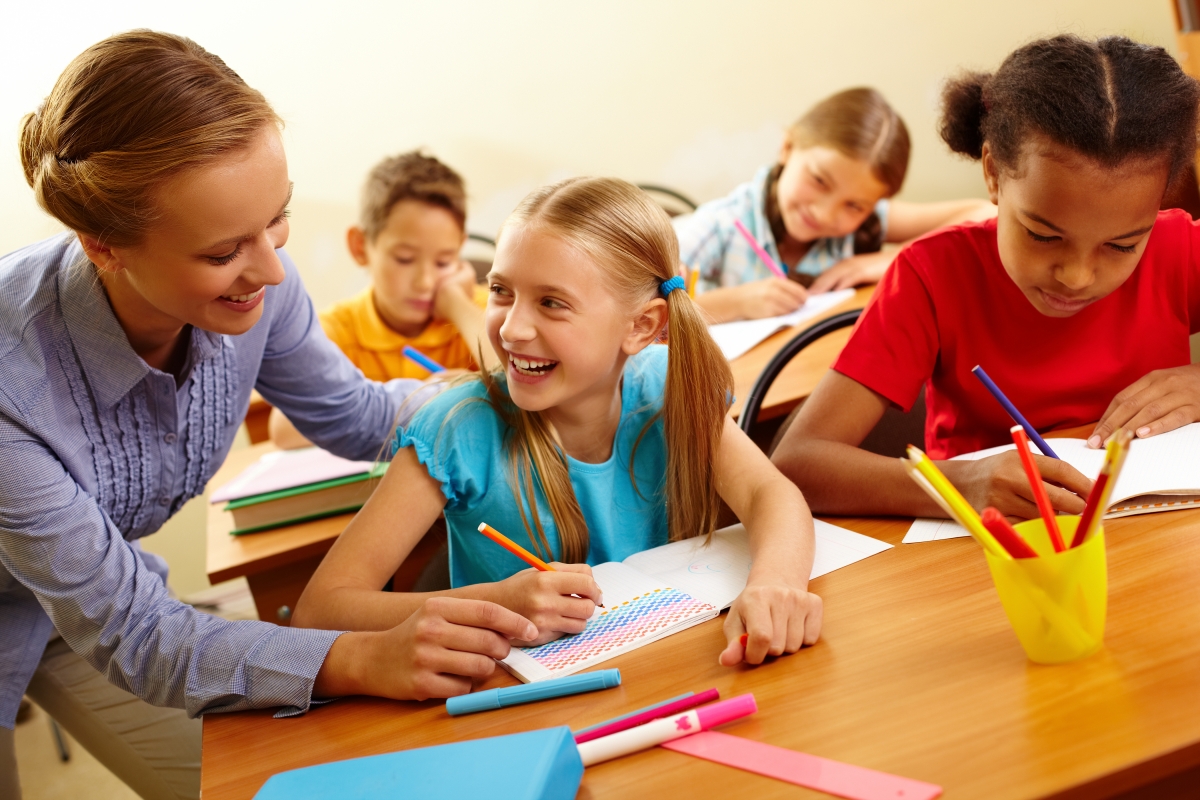
When back-to-school comes around, many of us worry about the inconvenient illnesses our children are sure to catch in the classroom - for many, runny noses and sore throats are an inevitable part of being in the school environment.
Yet, few of us realize that our children are at risk for catching more than just colds and flus. Yes, there is something else invisible, silent, and potentially harmful they can bring home from school. Fortunately, unlike these illnesses, it is fully preventable...
We're talking about STRESS!
While the classroom can be a wonderful place for learning and socializing, the demands placed on teachers[1] can sometimes feel overwhelming. Research conducted by Dr. Kimberly Schonert-Reichl, NoVo Foundation Endowed Chair in Social and Emotional Learning, Professor - Department of Psychology, University of Illinois at Chicago, suggests that this overwhelm - which can lead to emotional exhaustion and burn-out among teachers - can affect their students too, in the form of stress contagion, which occurs when stress crosses over from one person to another.
 Schonert-Reichl and colleagues have discovered evidence[2] that stress contagion takes place in schools. This finding is supported by other research[3] that demonstrates stress contagion takes place in other environments as well, such as within families.
Schonert-Reichl and colleagues have discovered evidence[2] that stress contagion takes place in schools. This finding is supported by other research[3] that demonstrates stress contagion takes place in other environments as well, such as within families.
Fortunately, the same process that allows stress to be transmitted in the classroom[4] can also lead to the spread of more positive influences, such as motivation, expression, enjoyment, and happiness.[5] When it comes to creating calm in the classroom, this means that teachers have the opportunity to make their learning environments Secure & Calm for their students, simply by feeling more Secure & Calm themselves.
Schonert-Reichl's research [6]reveals that one way to achieve this is through social-emotional learning[7] for teachers. Additional ways to boost teachers' sense of Secure & Calm include addressing the factors that can lead to burnout, such as overwhelming workloads, extreme academic pressures, and not enough support from their colleagues and communities.
In order to stop the stress contagion before it begins, teachers, administrators, parents, and students can work together to address these risk factors at their source by using the Five Heart-Mind Qualities as a roadmap to calm teachers, calm students.
How to Cultivate Calm Classrooms with Heart-Mind Well-Being
As children and teachers prepare to return to school this September, a focus on Heart-Mind Well-being can go a long way towards preventing teacher burn-out and fighting the stress contagion before it begins. Read on for tips on how to engage with each of the 5 Heart-Mind Qualities in order to make this back-to-school a calmer one.
- Secure & Calm: Starting the day off right begins before teachers and students enter the classroom. Give yourself (and your child) enough time to get ready, out the door, and travel to school in the morning to avoid rushing.[8]
- Compassionate & Kind: Teaching has been found to be one of the most emotionally draining jobs there is. Be kind and compassionate with the teachers in your life (including yourself!)[9], especially when you feel like they are not performing their best.
- Gets Along with Others: Not everyone gets along easily, be it in a classroom, workplace, or family. When childrens' personalities clash at home or in the classroom, it can help for parents and teachers to think of their role as mediators, not referees. [10]
- Alert & Engaged: Teachers have enough on their plate teaching the curriculum, without taking into account dealing with distractions or disruptions in the classroom. While some level of daydreaming and off-topic discussion is to be expected within any classroom, students do have the power to make their best effort to stay alert and engaged during lessons[11].
- Solves Problems Peacefully: As a parent, you may not always agree with how your child's teacher handles a disagreement between students, or feel that your child is graded fairly. And as a teacher or administrator in a school environment, things are bound to come up that leave you feeling at odds with your colleagues. While conflict can be a major stressor, when it is handled with respect and collaboration, it doesn't have to be. [12]
Image credit: https://www.freepik.com/free-photo/happy-teacher-listening-her-students_...
In a 2007 study, researchers Oberle and Schonert-Reichl analysed stress levels of 406 4th to 7th grade students and their teachers in Vancouver, BC. They measured cortisol levels present in the students' saliva, which is a physiological indicator of stress, and also asked teachers to complete a questionnaire measuring burn-out. The researchers found that the students' and teachers' stress levels were linked, and that children's cortisol (stress levels) were significantly higher in classrooms where the teachers experienced burn-out.
Schonert-Reichl lists heavy workloads, lack of support, and the pressure of high stakes testing as contributing to teacher burn-out. She also suggests that teachers can experience stress when they "appraise a situation as threatening but have limited ability to change or improve it."
For example, in a 2014 study, Waters, West, & Mendez found that infants mirrored their mothers' emotional reactivity when they were reunited after being separated for a stressful experiemental task.
Further, in analysing a representative sample of 10,700 American first-graders, Milkie & Warner (2011) found that children in less positive classroom environments - such as those lacking material resources or where teachers are less respected by colleagues, have more social-emotional problems (eg. learning, behavioral, interpersonal, mental health challenges).
This research, in addition to Schonert-Reichl's, supports "stress contagion theory", in which argues that stress within a shared social setting can spill over from one person to another.
Burgess et al. (2018) conducted a review of academic literature on "The Influence of Social Contagion Within Education," and summarized these findings from other scholars' research.
https://www.ncbi.nlm.nih.gov/pmc/articles/PMC5522461/
- describe scientific mechanisms underlying stress/social contagion? in one line after the sentence bolded with the links?
"Social contagion" explains how stress can spread between individuals. According to the Oxford Dictionary of Psychology, social contagion refers to "the spread of ideas, attitudes, or behaviour patterns in a group through imitation and conformity," and is also sometimes referred to as "behavior contagion."
Social-emotional learning is one of the theories underlying the 5 Heart-Mind Qualities, upon which Heart-Mind Well-being is based.
In 2017, Schonert-Reichl conducted a review of scholarly literature to investigate how to promote social-emotional learning in the classroom. This review investigated teachers' and students social-emotional well-being in relation to social-emotional learning programs delivered in schools.
Among several findings, the review found that teachers' beliefs about their teaching capacity and amount of support affect how they deliver social-emotional learning programs to their students. It also found that mindfulness-based social-emotional & stress management learning programs for teachers are effective at boosting their SEL competence and well-being.
When students, teachers, or even parents bustle into the classroom late or in a hurry, they bring their stress with them. Through the stress contagion, this stress can spread and affect the entire class, affecting everyone's ability to teach and learn effectively.
Feeling unsupported is a key risk factor for teacher burnout, which can affect the entire class. Bring a teacher a coffee, offer a kind word at drop-off or pick-up, and think twice before marching into the classroom to dispute a grade. Model kindness and respect towards your child's teacher, and your child is sure to notice that a little bit of kindness can ripple out in a big way.
Help children listen, share, and cultivate empathy in relationship to those who they may struggle to get along with. Doing so can help diffuse tensions at home and in the classroom before they start. Supporting children in building these skills over time can equip them with foundation of healthy relationships for life.
Parents can help their children learn how to focus and stay on task, to a developmentally appropriate level, by playing mindfulness games at home (teachers can use these in the classroom too!). Teachers can help keep the class focused by providing regular movement breaks and outdoor time to break up long stretches of carpet time or desk-bound study.
Remember that any stress you bring into a classroom, such as through conflict, can negatively affect students, so try to settle things outside the classroom or after school hours, and keep the Five Heart-Mind Qualities in mind while doing so.